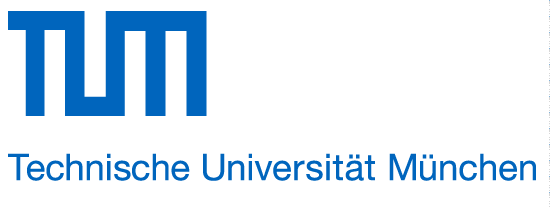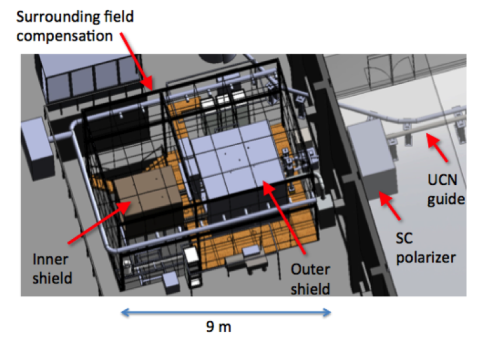MLZ is a cooperation between:
 > Technische Universität München
> Technische Universität München > Helmholtz-Zentrum Hereon
> Helmholtz-Zentrum Hereon
 > Forschungszentrum Jülich
> Forschungszentrum Jülich
MLZ is a member of:
 > LENS
> LENS > ERF-AISBL
> ERF-AISBL
MLZ on social media:

MLZ (eng)
Lichtenbergstr.1
85748 Garching
EDM (under construction)
Neutron electric dipole moment measurement
An electric dipole moment (EDM) of the neutron would be a clear sign of new physics beyond known particle physics. The search for this phenomenon is considered one of the most important experiments in fundamental physics and could provide key information on the excess of matter versus antimatter in the Universe. With high measurement precision, this experiment aims to ultimately achieve a sensitivity of 10-28 ecm for a charge distribution within the neutron. This can be interpreted as a probe of the early Universe, less than 10-11 s after the big bang, complementary to experiments at CERN and also beyond the reach of accelerators. In the Neutron Guide Hall East, a new instrument to search for the neutron EDM is currently being commissioned.
At a later stage, ultra cold neutrons (UCN) will be provided by a source in beam tube SR-6. In the instrument’s centre, the UCN are trapped in a box, where Ramsey’s method of separated oscillatory fields is used to precisely measure Larmor precession of UCN over hundreds of seconds as an interferometer in time in a small (about 1 μT) magnetic field. A deviation of the Larmor precession in the simultaneous presence of the magnetic field and a strong electrostatic field would be an indication for an EDM. While the UCN source will provide the required neutron density of 1000 per cm3 in the instrument, it itself is optimised to control any systematic effects.
A dominating issue to achieve this precision is the quality of the magnetic environment. Currently, it provides an extended volume (~0.5 m3) of 100 pT or less absolute field and a temporal stability of < 10 fT in 1000 s without any active measures. This corresponds to about the magnetic field in between stars in the milky way.
The shielding factor against external distortions of 6 Mio at 1 MHz and > 108 at 10 Hz. Inside this volume, magnetic fields of up to few μT can be applied vertically and horizontally with a homogeneity of better than up to 10-4 relative precision. During the commissioning phase, the volume is used for optical magnetometry and precision spin-clock measurements, as well as for the comparison of precision magnetometers. To apply electrostatic fields, a bipolar 200 kV source with stabilisation on Pockels effect is implemented.
- Ramsey-measurements with trapped ultra-cold neutrons
- Probing the isotropy of the Universe and its invariance under Lorentz transformations via clock comparison measurements with polarised gases
- Measuring new forces at short distances: search for dark matter candidates (axions etc.)
- Precision magnetometry and magnetometer development
- Ultra low field NMR
- Magnetic material screening on pT level
The EDM facility consists of a magnetically shielded room surrounded by 180 fluxgate magnetometers and 24 coils for external field compensation. The magnetically shielded room consists of an outer and an inner room, which can be used independently or slid into each other. Experiments with 2 × 2 × 2 m3 dimensions can be placed inside the shields in a pre-assembled state through a door of 2 × 2 m2. The furniture inside is non-magnetic and either 3D-printed or made from wood, external equipment can be degaussed on-site. Stable current sources with ppm stability over > 1000 s can provide DC magnetic fields with up to 5 μT.
External compensation- Size: 9 × 6 × 6 m3
- Number of coils: 24
- Number of magnetometers: 180
- Field: < 5 μT (DC)
- Active feedback frequency: 10 Hz (max.)
- Inner dimension:
- h = 2.3 m, w = 2.5 m, l = 2.8 m
- Residual field: < 0.5 nT in 1 m3
- Damping factor:
- 279 at 0.01 Hz, > 10000 at 10 Hz
- Inner dimension:
- h = 1.5 m, w = 1.5 m, l = 2.1 m
- Residual field: < 0.1 nT in 0.5 m3
- Damping factor:
- 6.000.000 at 0.001 Hz, > 108 at 10 Hz
- Fully optical Cs magnetometers (< 30 fT in 40 s resolution)
- 199Hg magnetometers (< 20 fT in 100 s)
- SQUID magnetometers and gradiometers
- SEOP polarisation of 3He and 129Xe at the experiment
Instrument scientist
Prof. Dr. Peter Fierlinger
Phone: +49 (0)89 35831-7131
E-Mail: peter.fierlinger@tum.de
Operated by

Publications
Find the latest publications regarding EDM in our publication database iMPULSE:
Citation templates for users
In all publications based on experiments on this instrument, you must provide some acknowledgements. To make your work easier, we have prepared all the necessary templates for you on this page.
Gallery


MLZ is a cooperation between:
 > Technische Universität München
> Technische Universität München > Helmholtz-Zentrum Hereon
> Helmholtz-Zentrum Hereon
 > Forschungszentrum Jülich
> Forschungszentrum Jülich
MLZ is a member of:
 > LENS
> LENS > ERF-AISBL
> ERF-AISBL
MLZ on social media:



